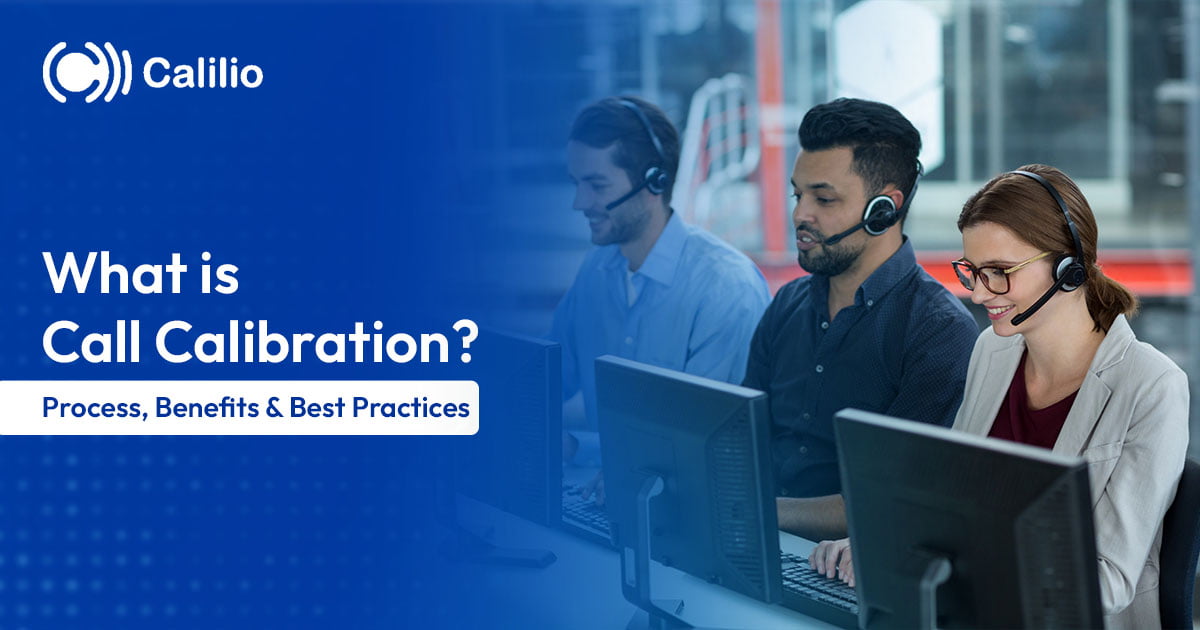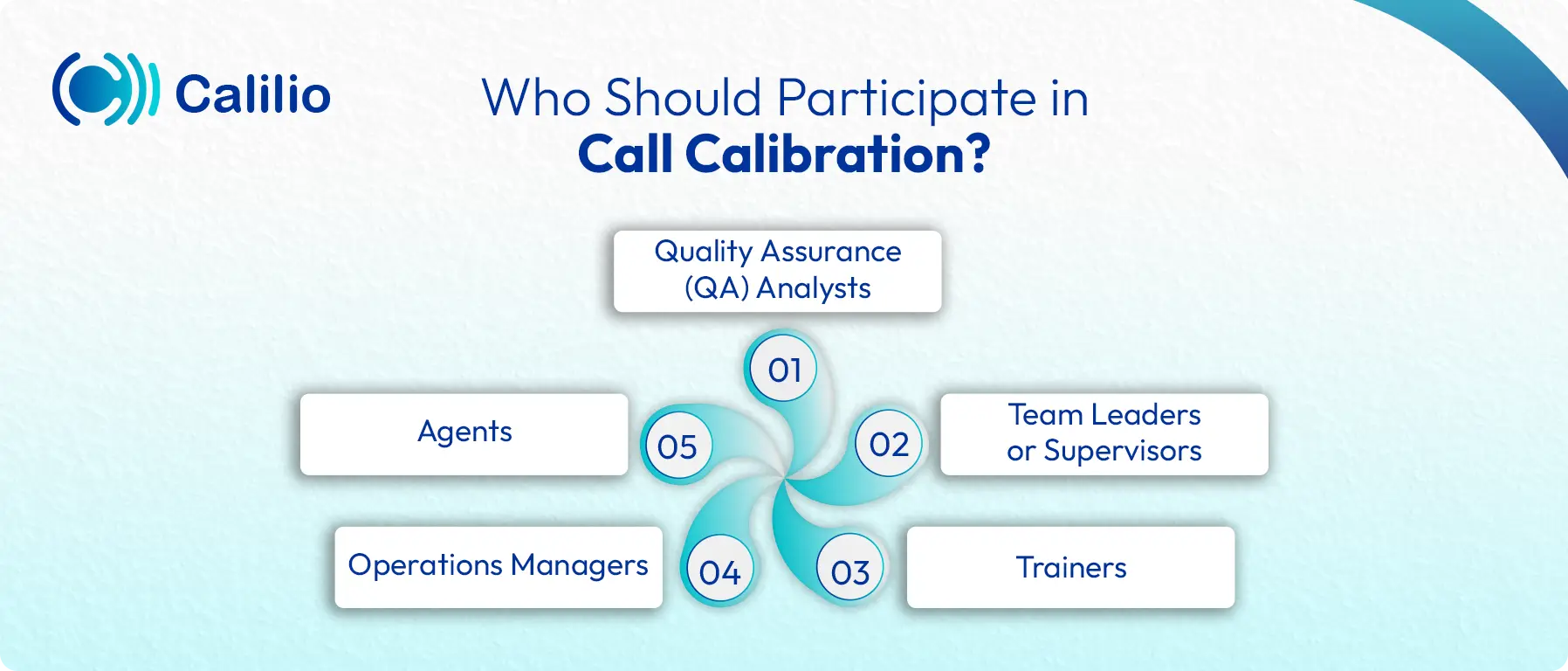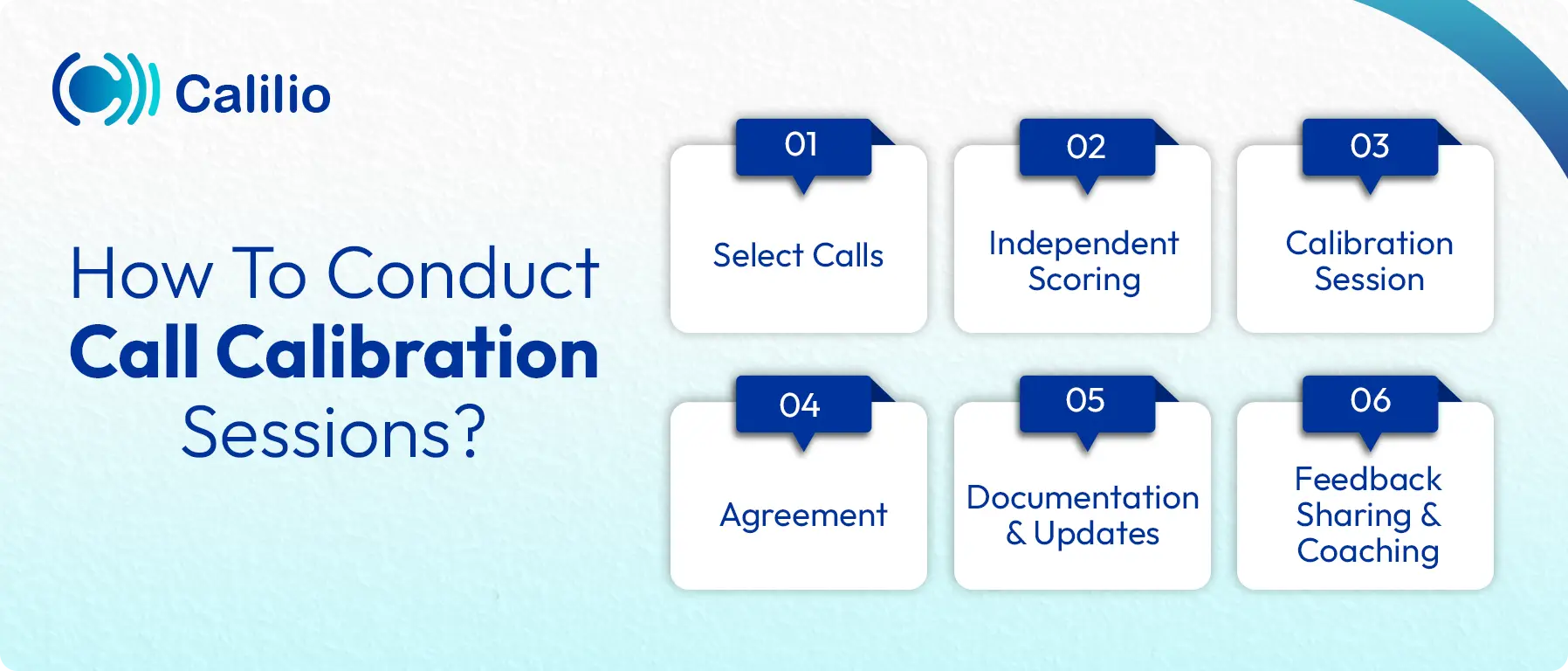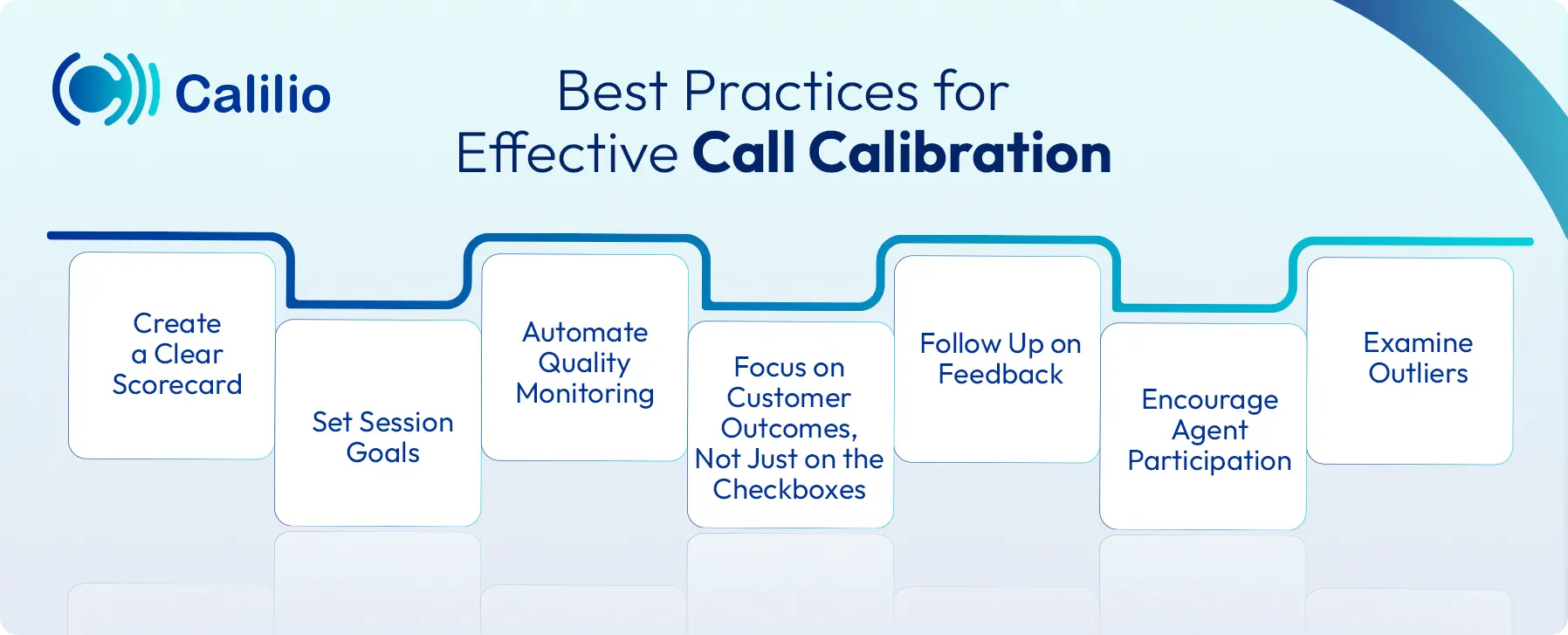What is Call Calibration in Call Centers? A Complete Guide

Evaluating performance is vital for call centers to measure how well agents and the organization are doing. But when different evaluators review the same calls, results can vary widely due to personal judgment.
To overcome this inconsistency, call centers use call calibration, a process that aligns multiple reviewers on shared quality standards. By doing so, it ensures fair, accurate, and consistent evaluations across the board.
In this guide, we’ll break down what call calibration is, how calibration sessions work, who should participate, the benefits it brings, common challenges, and the best practices to make it effective.
Highlights:
Call calibration is the process of bringing multiple evaluators together to review the same customer interactions in a call center.
QA analysts, supervisors, trainers, managers, and agents usually take part in call calibration sessions.
Call calibration ensures consistent evaluations, better coaching, stronger engagement, improved QA accuracy, and enhanced customer experiences.
The call calibration process often faces challenges such as subjectivity, time constraints, vague criteria, and lack of follow-through.
Best practices for efficient call calibration are to use well-defined scorecards, set goals for each session, automate monitoring where possible, focus on customer outcomes, and regularly follow up on feedback.
What is Call Calibration?
Call calibration is a quality assurance process where different evaluators, including supervisors, managers, and agents, assess the customer interaction using the same quality standards and guidelines. It ensures consistent performance evaluation across the call center, regardless of who reviews the call.
Instead of each evaluator interpreting the same conversation differently, calibration creates a shared standard that keeps scoring accurate and reliable. This is one of the best practices of call center quality assurance for accurate evaluations of customer interaction and agent performance.
What is a Call Calibration Session?
A call calibration session is a formal meeting among the call center managers and stakeholders (usually supervisors, agents, or other evaluators) to review customer interaction and employee performance, comparing the scores from each participant using the same call center KPIs.
During the session, each team member evaluates the same call individually, and then their reports are compared side by side. This allows the team to identify scoring discrepancies and make necessary adjustments. It ensures that all agents are assessed fairly and consistently. The goal is to maintain standard performance benchmarks and eliminate bias when evaluating employee performance.
Who Should Participate in Call Calibration?
In a call center, quality analysts, supervisors, trainers, and managers usually participate in call calibration. Everyone who is responsible for tracking employee performance, providing coaching, and making decisions about performance standards takes part in the sessions.

- Quality Assurance (QA) Analysts: Quality analysts mostly look after the quality of the calls. They focus on maintaining call quality and ensuring that performance metrics align with organizational standards.
- Team Leaders or Supervisors: They monitor the agents on a daily basis. Their input is vital in defining realistic and fair evaluation criteria.
- Trainers: Trainers should join calibration sessions to align coaching and training needs with actual performance standards.
- Operations Managers: Operations managers oversee compliance, efficiency, and customer satisfaction. Their participation in calibration sessions ensures that quality standards evolve with business needs and regulatory requirements.
- Agents: While agents aren’t required in every calibration session, their occasional involvement adds transparency. It also gives them a chance to share their view of quality standards based on their front-line experience.
Why is Call Calibration Essential for Call Centers?
Call calibration is essential for the consistent and fair evaluation of calls, improving employee training, enhancing customer experience, and refining quality assurance standards. It also strengthens collaboration among managers, supervisors, and trainers by aligning everyone on shared performance expectations.
Ensures Consistency and Fairness
Call calibration addresses inconsistencies that arise when employees in similar roles are rated differently due to personal judgment or varying expectations. By aligning all evaluators on the same QA standards, it keeps scoring consistent across teams, minimizes bias, and supports fair performance evaluation.
Improved Training through Feedback
When calibration sessions are held, evaluators can share feedback and discuss different scoring approaches. The exchange helps trainers identify where agents may need additional coaching. Over time, it creates more effective training programs tailored to real performance gaps.
Enhanced Customer Experience
Call calibration helps agents clearly understand the performance and quality standards they are expected to follow when handling customers. With this clarity, they can focus on meeting expectations more effectively, which in turn improves service consistency, strengthens customer trust, and contributes to higher satisfaction.
Improved QA Accuracy and Metrics
Call calibration creates a standard scoring criterion and reduces inconsistencies in evaluations. It supports quality assurance, tracks performance metrics, highlights areas for improvement, and provides leadership with data-driven insights for better decision-making.
Enhanced Engagement and Collaboration
Call calibration encourages greater engagement and collaboration among the quality analyst, trainers, supervisors, management and agents. When they review calls together and align on standards, teams build a shared understanding of quality, reduce disagreements and create a more cooperative approach to performance evaluation.
How To Conduct Call Calibration Sessions?
To begin the call calibration sessions, evaluators first select the same call recordings and independently score them using the standard QA criteria. During the meeting, they compare results, discuss discrepancies, document necessary adjustments, and use the outcomes to guide coaching and training efforts.

- Select Calls: A sample of customer interaction, such as a call recording or call transcription, is chosen for the review.
- Independent Scoring: Each participant (QA, supervisors, sometimes trainers) listens to the same call and scores it based on the quality guidelines or scorecard.
- Calibration Session: Evaluators meet to review the scoring. The team compares scores to see where they align and where they differ.
- Agreement: The group discusses the differences and similar scores and finalizes how future calls should be evaluated while following the session outcome.
- Documentation and Updates: The team refines the existing QA guidelines and scorecards based on the calibration session. The changes are documented and shared with the team.
- Feedback Sharing and Coaching: Supervisors use the results of calibration sessions to provide consistent and effective coaching for agents. In addition, these sessions also help improve quality assurance checklists for future evaluations.
What are the Common Challenges in Call Calibration?
Common challenges in call calibration include difficulty in objectively measuring soft skills, unclear evaluation criteria, and sessions that are often time-consuming. Additionally, a lack of follow-up and agent resistance to feedback can hinder the effectiveness of calibration efforts.
Subjectivity in Soft Skills
Soft skills like empathy, tone, and active listening are harder to measure than the compliance criteria, such as adherence to scripts or call handling procedures. One reviewer might rate an agent’s tone as professional, while another might see it as flat or disengaged. Without precise behavioural examples in the scorecard, these differences create inconsistent scores.
Time-Consuming Sessions
Calibration requires multiple people to listen to the same calls, score them independently, and then debate differences. Reviewing even a small batch of calls can take hours, which can delay feedback to agents and reduce the number of calls monitored overall.
Unclear Evaluation Criteria
If the scorecard uses vague wording like “shows empathy” or “offers solutions,” reviewers may interpret it differently. For example, one reviewer may expect the agent to apologize, while another might consider offering an alternative solution as enough. The lack of specificity creates scoring gaps that frustrate both evaluators and agents.
Agent Resistance
Agents may push back when feedback feels inconsistent or subjective, especially if scores affect performance reviews or incentives. If they perceive calibration as unfair, they may disengage from coaching sessions or argue against the feedback instead of using it constructively.
Lack of Follow-through
At times, after the calibration sessions, teams may fail to implement the agreed-upon standards in daily evaluations, which can undermine the entire process. When the insights from calibration go unused, it leads to recurring inconsistencies.
Best Practices for Effective Call Calibration
Effective call calibration requires a clear scorecard, well-defined session goals, and tools like automated quality monitoring to reduce subjectivity. It’s equally important to focus on customer outcomes, follow up on feedback, examine outliers, and involve agents to ensure transparency and continuous improvement.

Create a Clear Scorecard
At first, it is essential to create a call center quality assurance scorecard that defines behaviours in measurable terms, not broad labels. Instead of “show empathy”, describe it as “acknowledges the customer’s concern before offering a solution.” It makes it easier for evaluators to stay aligned and for agents to understand expectations.
Set Session Goals
Each call calibration session should begin with a clear objective, such as aligning evaluators on scoring, addressing specific performance gaps, or updating quality standards. Having a defined goal keeps the discussion focused, productive, and ensures actionable outcomes.
Automate Quality Monitoring
Instead of monitoring every call manually, call centers can use a call center software that offers automation features such as speech analytics or quality monitoring tools. It can help you to automatically track keywords, compliance phrases, and handle times. This frees up calibration sessions to focus on more complex areas, like evaluating soft skills, where human judgment is most valuable.
Focus on Customer Outcomes, Not Just on the Checkboxes
Calibration should go beyond ticking boxes on a scorecard and instead emphasize the overall customer experience. By prioritizing outcomes such as issue resolution, satisfaction, and relationship building, evaluators ensure that performance standards truly reflect the quality of service delivered.
Follow Up on Feedback
Calibration doesn’t end when the session does. Teams must update the scorecard, share agreed standards with all evaluators, and ensure agents receive similar feedback in coaching sessions. Without further follow-up and strict implementation, the same performance issue is likely to resurface in the future.
Encourage Agent Participation
Call centers should encourage agents to join calibration sessions so they can better understand how their performance is evaluated. This involvement builds transparency and strengthens trust in both the system and the evaluators. It also gives them a platform to explain challenges they face on the frontline.
Examine Outliers
If one evaluator constantly scores higher or lower than others, their approach should be reviewed. Such outliers may indicate misunderstandings of the criteria or personal biases. So, those outliers need to be addressed to help maintain balanced, uniform, and fair scoring criteria across the team.
Conclusion
Call calibration is key to keeping call center evaluations fair, consistent, and effective. It aligns evaluators to the same criteria, refines QA standards, and shares clear feedback. Moreover, it improves coaching, boosts agent performances and improves customer experiences. While it comes with a few challenges, following best practices can make calibration a powerful tool for both performance improvement and service quality.
A modern business phone system like Calilio can make call calibration even easier and more effective. Its VoIP features, such as call recording, AI-powered transcription, sentiment analysis, and detailed call reports, equip managers with the insights they need to evaluate performance accurately and coach effectively.

Get Cashbacks Up to 43% Straight To Your Wallet!
Unlimited Virtual Numbers – Local, Mobile & Toll-Free from 100+ Countries
Free Local Phone Number from US or Canada
Crystal-Clear Calls Starting at Just $0.0153/min
24/7 Human Support – Because Great Service Never Takes a Holiday


Frequently Asked Questions
What is the purpose of calibration?
The key purpose of call calibration is to ensure consistency and fairness in how calls are evaluated. It reduces bias, aligns evaluators to the same standards, and provides agents with proper feedback to improve their performance.
What is calibration in QA?
What happens during a calibration meeting?

Still have questions?
Can’t find the answer you’re looking for? Please chat with our friendly team.
Stay in the loop
Get the latest call insights, trends, and updates delivered straight to your inbox.
By subscribing, you agree to receive updates from Calilio.
You can unsubscribe anytime.